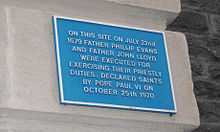Philip Evans and John Lloyd
Saints Philip Evans and John Lloyd were Welsh Roman Catholic priests. They are among the Forty Martyrs of England and Wales.
Father Philip Evans
.jpg)
Philip Evans was born in Monmouth in 1645, was educated at Jesuit College at St. Omer, joined the Society of Jesus in Watten on 7 September 1665, and was ordained at Liège and sent to South Wales as a missionary in 1675.[1][2]
He worked in Wales for four years,[1] and despite the official anti-Catholic policy no action was taken against him. When the Oates' scare swept the country both Lloyd and Evans were caught up in the aftermath.[3] In November 1678 a John Arnold, of Llanvihangel Court near Abergavenny, a justice of the peace and hunter of priests, offered a reward of £200 (equivalent to £30,000 in 2015)[4] for his arrest.
Despite the manifest dangers Father Evans steadfastly refused to leave his flock. He was arrested at the home of a Mr Christopher Turberville at Sker, Glamorgan on 4 December 1678.
Father John Lloyd
Father John Lloyd, a Welshman and a secular priest (a priest not associated with any religious order), was a Breconshire man.[5] He was educated in Ghent, and from 1649 at the English College, Valladolid, Spain.[6] He took the 'missionary oath' on 16 October 1649 to participate in the English Mission. Sent to Wales in 1654 to minister to covert Catholics, he lived his vocation while constantly on the run for 24 years. He was arrested at Mr Turberville's house at Penlline, Glamorgan on 20 November 1678, and imprisoned in Cardiff Gaol.[7] There he was joined by the Jesuit, Philip Evans.[7]
Trial
Both priests were brought to trial in Cardiff on Monday, 5 May 1679.[7] Neither was charged with being associated with the plot concocted by Oates. Nonetheless, they were tried for being priests and coming to England and Wales contrary to the provisions of the law, and were declared guilty of treason for exercising their priesthood.
Executions

The executions took so long to be scheduled that it began to appear that they might not take place. The priests were allowed a good deal of liberty, even to leaving the prison for recreation.[3] The executions took place in Pwllhalog, near Cardiff on 22 July 1679.[7] Two plaques mark the site at what is now the junction of Crwys Road and Richmond Road in Roath, Cardiff, still known as "Death Junction".[8]
Philip Evans was the first to die. He addressed the gathering in both Welsh and English saying, ‘Adieu, Father Lloyd! Though only for a little time, for we shall soon meet again'. John Lloyd spoke very briefly saying, ‘I never was a good speaker in my life'.
Canonisation and Feast Day
On 25 October 1970, both John Lloyd and Philip Evans, S.J. were canonised by Pope Paul VI.[1] Although they died on 22 July, this date is kept by the Catholic Church as the day of St Mary Magdalen, so their joint feast day was assigned to 23 July. The same date is the assigned day of St Bridget of Sweden, who was later designated one of six patron saints of Europe by Pope John Paul II. This means that while churches dedicated to St John Lloyd or St Philip Evans can keep their feast on 23 July, other churches must commemorate St Bridget on that date. A voluntary celebration for St John Lloyd and St Philip Evans may be kept on a nearby date at the discretion of local communities.[9]
Forty Martyrs of England and Wales
The Forty Martyrs of England and Wales' collective feast day was formerly kept on 25 October, but in England are now celebrated together with beatified martyrs on 4 May.[10] In Wales, 25 October is the feast of the 'Six Welsh Martyrs and their companions'.[9]
Dedications
St Philip Evans
- St Philip Evans Church, Llanedeyrn, Cardiff (Roman Catholic)
- St Philip Evans Catholic Primary School, Llanedyrn, Cardiff
St John Lloyd
- St John Lloyd Church, Rumney, Cardiff (Roman Catholic)
- St John Lloyd Catholic Comprehensive School, Llanelli
- St. John Lloyd R.C. Primary School, Trowbridge, Cardiff
Notes
- ↑ 1.0 1.1 1.2 "Saints and Martyrs", The Jesuits
- ↑ "Liturgy Office of Wales". Retrieved 25 April 2015.
- ↑ 3.0 3.1 Stanton, Richard. A Menology of England and Wales, Burns & Oates, Ltd., 1892
- ↑ UK CPI inflation numbers based on data available from Gregory Clark (2014), "What Were the British Earnings and Prices Then? (New Series)" MeasuringWorth.
- ↑ Inscription on a portrait in the Royal English College, Valladolid: "San Juan Lloyd, natural de Brecknockshire, Gales, colegical y sacerdote de este Colegeio de San Albano, murió por la fe católica fuera de Cardiff, Wallia, el 22 de Julio de 1679" (Saint John Lloyd, a native of Brecknockshire, Wales, student and priest of this College of St Alban, died for the Catholic faith outside Cardiff, Wales, on 22 July 1679). Image at "Ramblings from a Welshwoman abroad". 31 August 2011. Retrieved 26 April 2015., low-resolution image at "ST. John LLOYD". Royal English College, Valladolid. Retrieved 26 April 2015.
- ↑ "St. John Lloyd", Royal English College, Valladolid
- ↑ 7.0 7.1 7.2 7.3 Wainewright, John. "St. John Lloyd." The Catholic Encyclopedia. Vol. 9. New York: Robert Appleton Company, 1910. 4 Apr. 2013
- ↑ Wynn-davies, Therese (10 March 2011). "Spotlight: History of 'death junction'". The Guardian.
- ↑ 9.0 9.1 National Calendar for Wales, Liturgy Office for England and Wales, accessed 31 July 2011
- ↑ National Calendar for England, Liturgy Office for England and Wales, accessed 31 July 2011
Sources
Encyclopædia Britannica, 15th Edition